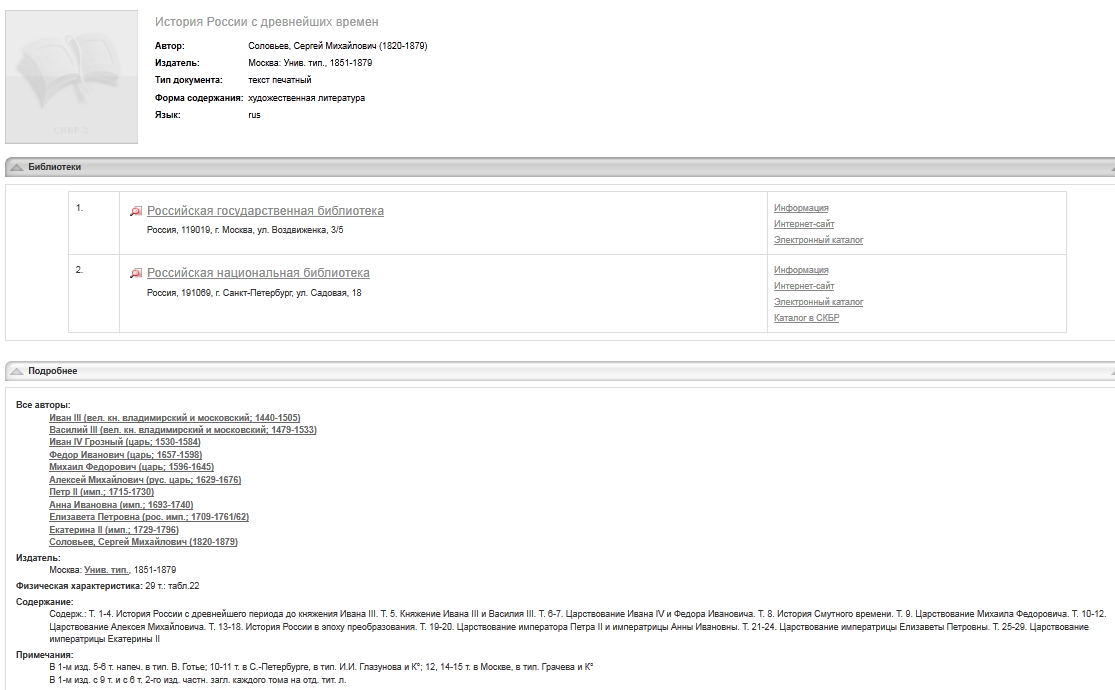Introduction
Electronic resources have proliferated impressively in the Russian context as they have in all geographical areas and intellectual spheres of research. Yet, there is a case to be made that in the Russian case this proliferation has been particularly unprecedented. As there has for generations existed a tremendous respect among Russian academics and learned people for not only knowledge but especially the management of it, bibliographers and bibliography as an institution of knowledge has always commanded great respect even despite the awful changes that have rocked the Russian academic community in recent decades. The current migration of knowledge to the world wide web in order to actively facilitate and expand access to it has been taken very seriously by Russian academicians and librarians and has in recent years, in contrast to the 1990s, received increasing recognition and, more importantly financial support, from the state. While there are literally hundreds of online organizations and search possibilities available on the Runet (Russian Internet), some of the most important for international scholars and academics researching and writing about Russia are to be found in the major Russian libraries, which is why this guide pays them particular attention.
Russian National Library
URL: http://www.nlr.ru/index.html
The Russian National Library (Rossiiskaia natsional’naia biblioteka, RNB) is the oldest public library in Russia, founded in 1795 during the reign of Catherine the Great. Some of the earliest materials that comprise its collection came from her, including Voltaire’s personal library. Much additional material came from Poland during the Polish Partitions, only some of which has been returned. The RNB opened to the public in 1814 as the Imperial Public Library. Its collection grew rapidly during the 19th century because of the Imperial censorship laws, which necessitated everything published in Russia to provide one copy for this, the national depository library until the Bolshevik Revolution. By 1914 the RNB held some 3 million volumes. In 1918 it was renamed the Russian Public Library, but during most of the Soviet era (from 1932 to 1992), it was known as the Saltykov-Shchedrin State Public Library. Renamed the Russian National Library in 1992 by Presidential decree, the RNB hosts one of the largest collections of materials in the world, with over 30 million items.
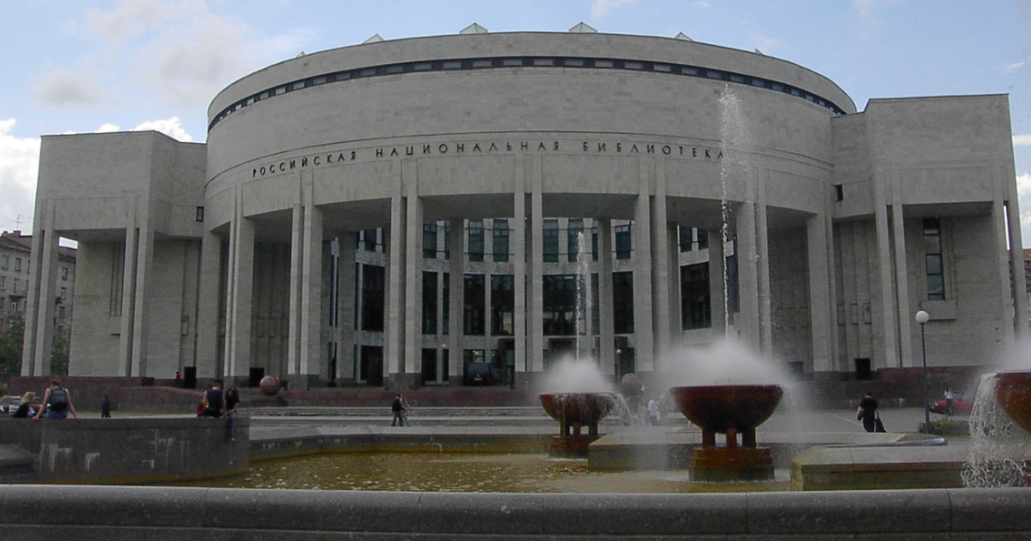
Catalogs of Books in Russian, Belorussian, and Ukrainian Languages
The website of the Russian National Library in Moscow is very rich in research possibilities. There are several OPACs (online public access catalog), or “electronic resources” to Russians. From the “resources” tab on the top left, go to the “catalogs” selection and finally to the “electronic catalogs.” Here, one can search one of many specialized catalogs of the national library, organized into groups. First is the section on books in Russian, Ukrainian and Belorussian languages. First again is the general electronic catalog for broader searching, http://primo.nlr.ru/primo_library/libweb/action/search.do. As with all Russian online sites, searching is in Russian using the Cyrillic script.

Below the general online search is one of the most heavily used of the RNB’s OPACs, the General Online Catalog of Russian Books from 1725-1998. Serving as proof of how seriously the Russian academic community takes organizing and storing knowledge, here one will find scanned copies of the entire catalog of the Russian National Library (some 8.5 million catalog cards), gateway to the some 6 million monographic collection of the RNB, arguably the most complete collection of materials in Russian, Ukrainian, and Belorussian. The main depository holdings for both the Tsarist and Soviet Empires, scanned and available for online browsing by author name, either personal or corporate. It does require a bit of patience. As with the scanned catalogs of the Jagiellonian University Library, the Czech National Library, or the Library of Congress’s Z39.50 Gateway, access is by “main entry” at http://www.nlr.ru/e-case3/sc2.php/web_gak, i.e. by author only, there is no subject access. In order to search this catalog, the user will enter a term on the search screen. The result returned will be a list of possible entry points for the catalog, rather like the tabs on index cards. Selecting one of these will position the user in a range of cards. The user must select the cards, by number and essentially “browse” the cards. Below is a sample entry from the catalog.
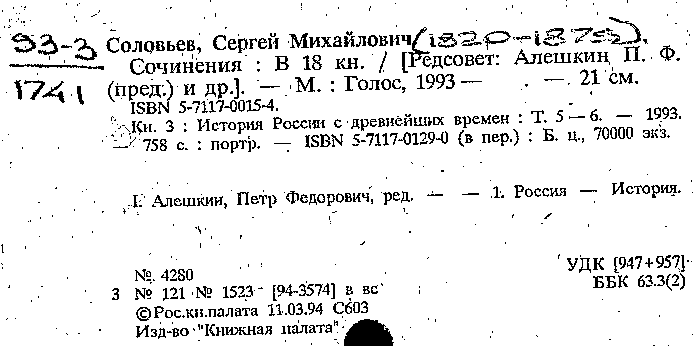
The catalog includes citations to periodicals, dissertations, and maps as well as monographs (although there are specialized catalogs for some of these). The precise holdings for periodicals are not included in this version of the catalog. However, the microfiche edition contains a supplement of periodical titles and holdings for the Russian National Library. The microfiche edition is available in the U of I Slavic Reference Collection.
Following this catalog is the union catalog of Russian books, http://www.nlr.ru/rlin/ruslbr_v2.php?database=RLINXVIIIn, but only for the immediate post-revolutionary era, from 1918-1926. However, the OPAC is much more flexible, allowing users to narrow their search to include title, author, place of publication and publishers, language of the document and even circulation number. There is an additional catalog specializing in Russian books for the previous century, from 1826-1917 which includes records from the six largest state collections in Russia (national library, state library, the library of the academy of sciences, the state public historical library, the state university libraries of Lomonosov in Moscow and Gorky in St. Petersburg), however access to this OPAC is obtained from the RNB only through special permission.
Of special note is the catalog of Russian Secular 18th Century Printed Books (Русская книга гражданской печати). This is a joint catalog of a large number of participating libraries and collections from all across the Russian Federation, including state and university libraries, museums and archives. Together these institutions have created access to digitized viewing of about 20,000 manuscripts and more than 5000 state manifestos and decrees, many of which were not open to the public before. This collection is searchable through the OPAC, which is similar to the Russian union book catalog above, permitting searching by many possible means, http://www.nlr.ru/rlin/ruslbr_v2.php?database=RLINXVIII.
Catalogs of Books in Foreign (European) Languages
Books in Foreign European languages from the Sixteenth Century comprise another database of this section of the RNB’s OPAC, including almost 40,000 titles held by the RNB (http://www.nlr.ru/rlin/in16.php). These include books on all subjects from theology to law including some rare books. Most of the entries are from handwritten bibliographic records from the Imperial Public Library in St. Petersburg. As such both the items and their records are constantly being digitized. Similarly, the specialized database for Fifteenth Century European materials is constantly being expanded through the additional of newly digitized items from the collection of the RNB’s rare books and manuscripts collection, the largest in the Russian Federation. Currently, more than half of some 6000 items in the RNB’s collection are accessible online at (http://www.nlr.ru/rlin/incunab.php).
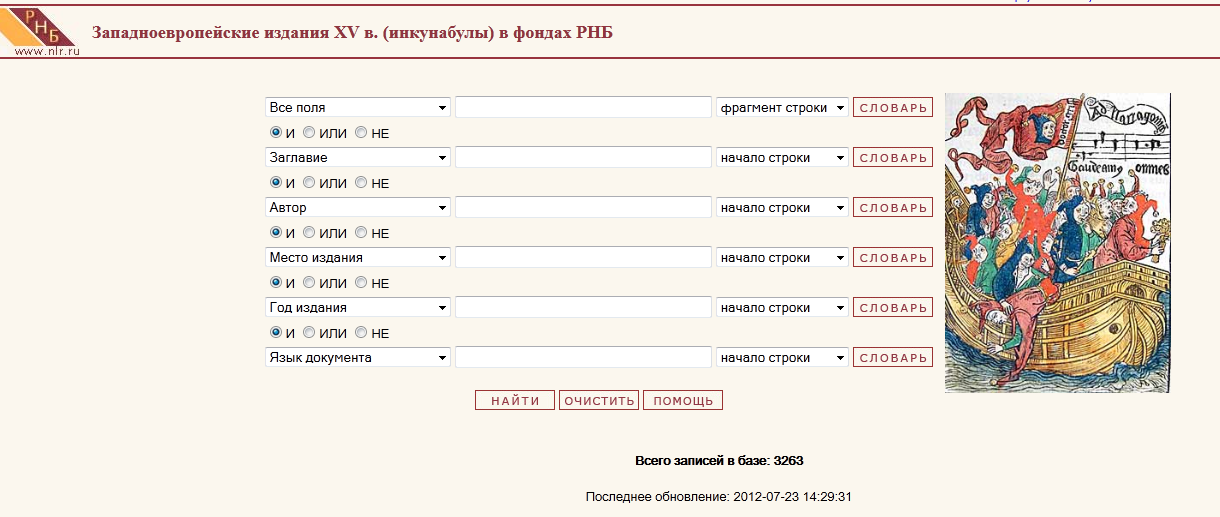
Also part of the foreign languages collection, the specialized electronic catalog for Finnish language materials includes monographs from 2002 and older from the RNB collection, and periodicals from beginning in 1957. Materials (both periodicals and monographs) that were collected after 2002 are in the general electronic catalog for Russian-language materials. Another specialized electronic catalog, Rossika, focuses on books dealing with Russia published in foreign languages (either abroad or in Russia), or books by Russian authors translated into foreign languages. This collection is focused only on older materials, those that came into the RNB collection before 1930. More recent materials can to searched for using the main electronic catalog. Additionally, there is another online catalog that allows searching for older foreign language materials published in Russia, that is based on the bibliographic work “Union Catalog of Books in Foreign Languages Published in Russian in the 18th Century,” published in 1984-86 in three volumes. Sixty percent of this online database overlaps with the Russica database. The Library of the First Cadet Corps (previously known as the Landed Gentry Cadet Corps, is another specialized catalog that is not, strictly speaking, focused on materials in foreign languages but nevertheless contains many such materials because of the aristocratic social status of many of its authors, which in the Russian context over the 18th and 19th centuries meant using foreign languages, particularly French. This catalog has streamlined access to a large collection of rare materials that belonged to cadets of this Corps, originally founded in 1732, including almost 7000 original monographs in foreign languages and over 300 original notebooks from some of the cadets. Finally, a newly founded (since 2006) online database of Yiddish language materials based on the holdings of RNB’s section known as OLSAA (Department of Literatures and Languages of Asia and Africa) allows searching of over 20,000 Yiddish language monographs and some 800 periodical titles. The periodical titles are also available for browsing as an alphabetized list, which is very useful in determining exact holdings. Searching is easiest in the Latin script, as all the titles in the database are accompanied with Latin script transliterations and, in some cases, by Russian language descriptions. All of these can be found in the national library list of electronic catalogs: http://nlr.ru/nlr_visit/RA1812/elektronnyie-katalogi-rnb.
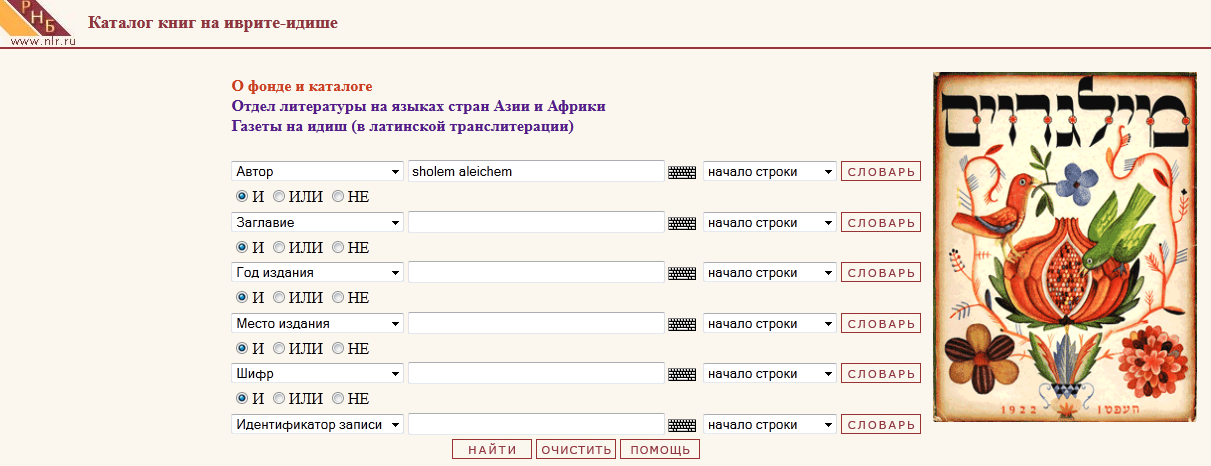
Catalog of Periodicals and Current Serial Publications
Perhaps the most used database collection of the Russian National Library is that of of its journals and periodicals (http://www.nlr.ru/rlin/Periodika_rus.php), not only for locating hard to find publications from years and centuries past, but also to verify the existence of rare and short-lived serials whose records in some cases exist nowhere else. The RNB catalog is extremely useful for its detailed information on the historical records of given publications, including tracking name and place of publication history over the course of its life. The first and primary database in this collection is the Catalog of Periodicals and Current Serial Publications in Russian, Ukrainian and Belorussian Languages, which is the result of an extensive project to digitize the card catalog records of the RNB periodical and journal collections since 1728. It is very important to note that Russian bibliographic tradition strictly separates periodical publications from newspapers. This database is not for newspapers, which is a separate OPAC. Also, while the periodical list is consistently being updated, this process does have interruptions which may be witnessed in certain searches. The periodical publication database has not been updated since July 2012.
In addition to the above, there exists an additional catalog that permits more in depth searching of Russian imperial journals from the reign on Alexander I, called “Russian Journals from the First Quarter of the 19th Century with Rospis Content” (http://www.nlr.ru/rlin/Periodika19v_1_3.php), which was prepared over the course of 11 years from 1995 to 2006 as part of the preparation of three-volume Union Catalog of Russian Periodic Publications, 1801-1825. There are nearly 30,000 entries in this database, and it is searchable by multiple means.
A sister database to the first listed in this section above, the Catalog of Periodicals and Current Serial Publications in Foreign (European) Languages (http://www.nlr.ru/rlin/Periodika_in.php) includes the large number of foreign-language periodicals in the RNB collection, again not including newspapers.
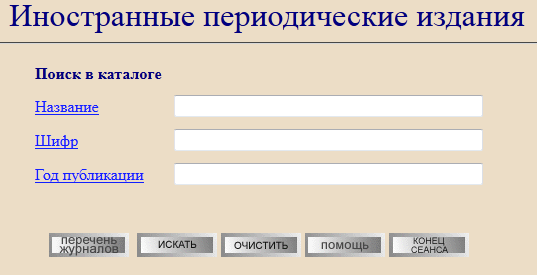
For newspapers, the RNB offers the site of its Union Catalog of Russian Newspapers, 1703-1917 (http://www.nlr.ru/rlin/svnewsp.php), which, similarly to its journals site, is tremendously good for checking on particular titles because of its detailed annotations that lay out the historical changes of each title in terms of publisher, place of publication, and the name itself. It is thus possible to check on small, regional papers that may have struggled and been published in various forms or very briefly, as well as the large, urban center or state supported publications. The database is also quite large, built on the records of three leading library collections in the Russian Federation: the Russian National Library (RNB), the Russian State Library (RGB), and the State Public Historical Library (GPIB). In cases where a known publication could not be found in any of these three places, historical newspaper records kept at the Science Library of the Federal Archives and the Vissarion Belinsky Universal Academic Library of the Sverdlovsk oblast in Yekaterinburg were used to fill in the gaps. The bibliographic collection contains entries of all Russian-language newspapers that were published on the territory of the Russian Empire per its borders in 1913, as well as Russian papers from large Russian diaspora communities. Through the additional links on the bottom of the OPAC page (below), patrons can visit additional useful links detailing the rules of the RNB newspaper reading room, information concerning copying, contacting the staff, as well as browse holdings of foreign newspapers in the RNB.
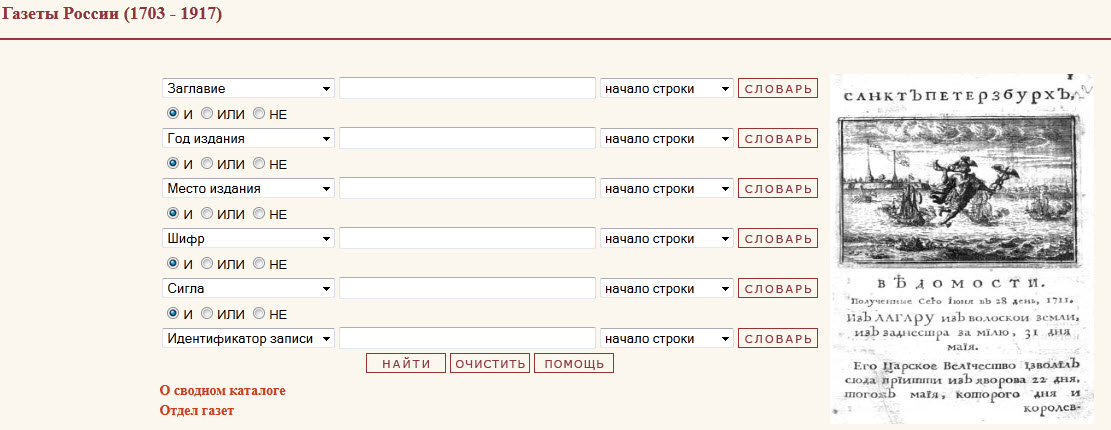
The final database included in the periodicals section is one for holdings of Yiddish language newspapers. The holdings are organized by their transliterated Latin-script names, based on the holdings of the RNB’s OLSAA, the Department of Literatures and Languages of Asia and Africa, just as with journals (above). The record here connects patrons to the same OPAC as is used with the journal entry above, and also provides access to the alphabetized, Latin-script listing of Yiddish-language newspapers held in the RNB OLSAA collection. In addition to the alphabetized name index, patrons can also browse holdings by geographical order, searching for papers by place of publication.
Catalog of Publications in Languages of the Peoples of the Former USSR
The catalog of publications in the various languages of minority peoples of the Soviet Union is organized into four separate databases: first the Finno-Ugric group, followed by small peoples, and then separate catalogs for Armenian and Georgian. This first database, the Unified Electronic Catalog of Finno-Ugric Languages (http://www.nlr.ru/rlin/ruslbr_v3.php?database=ONL), includes the following tongues: Vep, Izhorian, Karelian, Komi, Mansi, Mari, Mordvin, Khanty, Udmurt, and Sami. The pre-revolutionary collections in each of these languages were compiled in conjunction with the formation of state libraries specializing in materials in each of these languages, aided by significant linguistic expertise from Finland, which was then a part of the Russian Empire. In Soviet times the catalog kept growing, as it has since 1991. Currently, the database opens a portal to almost 20,000 titles, including monographs and periodicals.
In addition to the specific Finno-Ugric database, another catalog, the Electronic Catalog of Books in Languages of the Peoples of the Russian Federation and Countries of the CIS (http://www.nlr.ru/rlin/ruslbr_v3.php?database=ONL2) was begun in 2000 for all languages of the Russian Federation and participants in the Commonwealth of Independent States that have been acquired since 2000. This includes all languages except Russian and the Finno-Ugric languages for which patrons are encouraged to use databases above. This database is envisioned as becoming much larger in the future as materials in non-Russian languages from before the year 2000 are added to it retrospectively.
Finally, this section includes two alphabetized catalogs, one for Armenian (http://www.nlr.ru/e-case3/sc2.php/arman) and one for Georgian (http://www.nlr.ru/e-case3/sc2.php/gruzin) materials, the former from 1623 and the latter from 1629. Both are organized by alphabetical entries of scanned catalog cards from the Russian National Library’s card catalog materials, exactly as the electronic Russian book database above works. Because the card catalog entries provide translations of the titles into Armenian and Georgian, it is possible to enter search terms in Russian, but the results are given in Georgian and Armenian only, so without knowledge of these languages searching the RNB database is not useful. Both catalogs are alphabetically organized according to the Armenian and Georgian alphabets. The Georgian database grants access to over 105,000 scanned cards of various titles, while the Armenian database includes some 64,000 scanned titles.
Catalogs for Other Types of Documents
In addition to maintaining and updating the catalogs outlined above, the staff of the Russian National Library is in the process of creating and/or taking apart a host of other specialized catalogs in order to ensure that the collections of the RNB are most accessible to researchers. The Department of Printed Music and Sound Recordings (http://www.nlr.ru/e-case3/sc2.php/note), which contains titles from 1518 until the present, is currently in the process of being updated and is not yet searchable. The nearly 7000 titles of the Cartography Department (http://www.nlr.ru/rlin/kartogr.php) are available, however. The twin catalogs of the Alphabetized Geographical Catalogs of Russian Maps (http://www.nlr.ru/e-case3/sc2.php/cart) and Atlases (http://www.nlr.ru/e-case3/sc2.php/rus_atlas) contain over 60,000 scanned cards from the physical catalog between them regarding items currently housed in the Cartography Department. Similar to the alphabetized catalogs described elsewhere above, these holdings are organized by groups of cards that have to then be sifted through electronically to find the exact entry desired. Entry into the link is strictly by group, and not by individual title. Similarly, the RNB provides access to the card catalog of a rich collection of foreign maps (http://www.nlr.ru/e-case3/sc2.php/in_cart) and atlases (http://www.nlr.ru/e-case3/sc2.php/in_atlas) from 1600 to 2004, almost 50,000 cards recently added from the physical catalog. In the same vein, the RNB has recently placed the full card catalog of two additional libraries on its website: the the Catalog of Russian Historical Maps and Atlases (http://www.nlr.ru/e-case3/sc2.php/hist_rus), from 1700-2004, and Catalog of Foreign Historical Maps and Atlases (http://www.nlr.ru/e-case3/sc2.php/hist_in), from 1501-2004.
Another very useful catalog added to this group of databases is the Russian Union Catalog of Printed Maps from the 18th Century (http://www.nlr.ru/rlin/kartogr18.php). This is a large and rapidly growing list of old map titles and annotations, featuring maps in Russian, German, French and Latin from the 18th century. It includes access to catalog information on materials from both the Russian State and National Libraries, as well as from a host of museums across the Russian Federation.
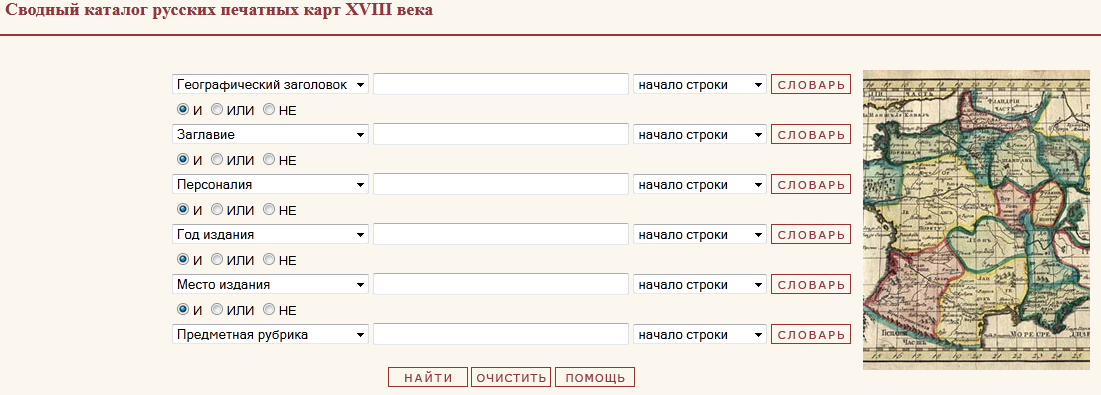
Additional specialized databases in this group include access to the Russian National Library’s electronic library. Here (http://nlr.ru/eng/coll/rare/), patrons are able to browse holdings of the Russian National Library’s catalog of rare materials as well as access its growing collection of full-text digitized materials available of many prominent items from Russia’s publishing history, including the full collection of Russian Imperial legal codes (http://www.nlr.ru/e-res/law_r/content.html), and access to the Russian State Library’s online library collection dissertations, the Electronic Dissertation Library (http://diss.rsl.ru/). An additional portal offering of full-text materials is the catalog Russia’s First Newspaper “Vedemosti 1703-1727, which provides access to digitized copies of the early years of Sankt Peterburgskie Vedemosti, Russia’s first printed newspaper begun by order of Peter I in 1702 (1703 in the Gregorian calendar). The early years of this paper, including its first decade when it was actually published in Moscow and was known as “Petrovskie Vedemosti,” are accessible through the Russian National Library’s electronic library. To access the full content of this growing electronic collection patrons are encouraged to register with RNB. Finally, there is an online database specializing in research on local issues around the Imperial capital, St. Petersburg. Literature about St. Petersburg , is a database allowing patrons to perform specialized searches scanning materials from various publications and journals that have been written about St. Petersburg. The project of creating a searchable database from over 600 journals and a wealth of monographic literature began at the RNB in 1989 and is currently up to 80,000 items, over 35,000 of which are available for online searching.

Russian State Library
The roots of the Russian State Library (Rossiiskaia gosudarstvennaia biblioteka, RGB) in Moscow go back to its founding as the Rumiantsev Museum in 1828 by order of Nicholas I in honor of Count Nikolai Petrovich Rumiantsev. In 1862, when this institution opened its doors to the public, it housed some 100,000 items. After the death of Vladimir Lenin, it was renamed in his honor and remained the Lenin Library until 1991, serving as the main depository library of the Soviet era. Since then it has been known as the Russian State Library, even though the metro stop servicing it is still called “Lenin Library.” Currently, it houses the largest depository collection in the Russian Federation and the second largest in the world, after the Library of Congress. Extensive holdings include both Russian and Foreign materials, including some 43 million titles in all formats, among which are 16.5 million books and brochures, 13 million journals, 650,000 newspapers, and 1.2 million serial titles. The electronic catalog of the RGB is sufficiently vast that an online instruction manual for electronic searching is recommended to all new users of the site. The online catalogs of the RGB are more flexible than those of the RNB, and it is possible to change the settings of one’s search within each catalog quite easily.
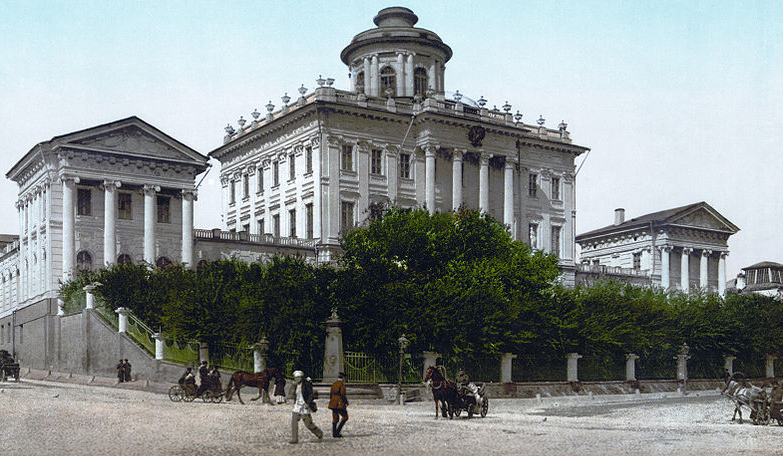
Rumiantsev Museum circa 1900 (Wikimedia Commons, http://commons.wikimedia.org/wiki/File:Pashkov_house.jpg?uselang=ru)
Unified Electronic Catalog
The primary, or unified catalog of the RGB is the broadest search engine available through the Russian State Library OPAC, although it does not permit patrons to access all titles held or accessible to the RGB, thereby necessitating searching in the other specialized online catalogs. Users will find, similarly to the RNB online databases, that while searching in English is possible, results will generally be disappointing. The database is constructed on Russian and the Cyrillic alphabet and searching in Russian will always render the best results. The online databases of the RGB are useful precisely because searching is possible in a variety of ways that the more restrictive RNB catalogs do not permit. In all OPAC searches, it is possible to set the search terms to permit a combination of words: marking yes will bring up entries only in the exact order indicated, whereas marking no will permit searching for each word and the combination also. In addition, for patrons with more specific information available, the catalog allows one to specify in what departmental library of the RGB they want to search, or in fact if the item is in, for example, a museum affiliated with the RGB database. One can also specify the language of the item from most world languages, as it is often best to search for the item in its original language if possible. Additional instructions for searching with symbols or only parts of words are given at the bottom of the OPAC page.

Among the immediate row of tabs above the search entry windows, the simple search tab takes patrons to the direct, basic search: a single search window that permits a broad array of search means including all elements, author, name of subject, personality (prominent author/subject), title, series, specialization code, subject, organization, field or industry, publisher, year of publication, place of publication, ISSN, ISBN, Index of the BBK, registration number and system number. Some of these are not known to common users and are designed for quick searching by librarians affiliated with the RGB. Others are not useful unless used in a more advanced search in conjunction with other search criteria (for example, just entering the year of publication will always fail to narrow your search because there will be too many hits, unless you are looking for something published in say, 1725). A more advanced search is offered by the second tab, a combination search that allows patrons to enter up to six fields including subject, author, personality, title, publisher, or all fields. The third tab “po neskol’kim BD” (on multiple databases) allows patrons to cross-search several catalogs at once. The fourth tab is for advanced searching, which is set up similarly to the simple search except that patrons are permitted to enter up to six cross-referenced items, three with a pull down menu of search parameters similar to the simple search, and three more terms entered directly by the patron. It also then allows a choice of permitting a combination word search or not. The fifth tabs takes patrons to the “Common Command Language” search, better known as a Boolean search.
Individual Catalogs
In addition to the general, or unified catalog described above, the State Library OPAC hosts several specialized online catalogs.
- Catalog of Books (Published from 1831 until the present) is the specialized monograph catalog, which in terms of the online interface is set up exactly like the unified catalog. Russian language monographic holdings of the RGB are largely complete for the period 1830 to 1917 and from 1980 until the present (its holdings for the majority of the Soviet period are considered weaker). In terms of monographs in other languages, particularly books from Asia and Africa, holdings are much more complete for the contemporary period, i.e. from 2000 onwards.
- The Catalog of Manuscripts consists of two elements: the Holdings Index of the Research Department of Manuscripts and the Catalog of Book Manuscripts . The former is a description of the Research Department of Manuscripts, including their holdings index of individual collections (fonds) of the archives and other sections. The latter is a catalog of the manuscript book holdings of the same department, including descriptions of manuscripts from the 11th to the 20th centuries.
- The Catalog of Old P rinted Books (published from 1450 to 1830 ) , has very thorough holdings for early Russian language printed books from 1708 to 1800, as well as some 16th and 17th century books printed in Latin. Also relatively complete are holdings of Russian books printed during the reign of Alexander I (1801-25), and printed books in Old Church Slavonic from the late 15th to the 19th centuries. Other chronological periods are covered less thoroughly.
- The Catalog of Theses and Dissertations is highly thorough for works completed in the late Soviet Union (since 1986) and post-1991 Russian Federation; but less than complete for earlier periods. Holdings include not only Russian theses but many international studies as well.
- The Catalog of Standards provides descriptions of items in the Government Standards (ГОСТ) collection, including all-Russian classification systems and other literature on standardization issues. Materials from 2004 to the present are the most complete materials; those from the previous years are less so.
- The Maps Catalog is relatively new. Its holdings are very thorough for the years since 2006 but less so for previous ones.
- The Catalog of Visual Materials is a relatively new database of access to lists of posters, prints , and bookplates that have been acquired by the RSL since 2007. The interface to the online catalog is the same in organization as the Unified Catalog.
- The Catalog of Note Materials includes electronic copies of musical publications held by the RGB, but focusing on pieces with particular cultural, literary or scientific importance. Currently, more than 13,000 items have been digitized and are accessible through this OPAC. Items in this digitized collection include music from all periods of Russian history, with the current exception of those dated between 1999 and 2005, which have yet to be digitized.
- The Catalog of Serial Publications (Except Newspapers) is, similarly to the RNB periodicals online database, strictly separated from newspapers. The database is not finished and remains under construction, which can affect searching. Coverage of serial publications in Russian and in the other languages of the former Soviet Union and Russian Empire are thorough, both for past and current periodicals. Foreign language serials are also available, though holdings are not as complete. For searching for serials in foreign languages, it is best to use the language of the publication, instead of either transliterating or translating the original title (for example, a search for “Time” provided several pages of hits including the popular American periodical, whereas searching for тайм or време failed). The online interface is in other respects exactly like the Unified Catalog.
- The Newspaper Catalog specializes in newspapers in the Russian language, although of course its collection includes many newspapers in other languages of the Former Soviet Union and the Russian Empire before. Like the periodicals catalog, this site remains under construction and is incomplete. Holdings for foreign language newspapers is weaker than for periodicals. The RGB’s newspapers collection is stored in the Khimki Book Repository branch in northwest Moscow.
- The Microform Catalog is a relatively new department within the State Library structure and its OPAC is new as well, dating from only 2002. The RGB is consistently increasing the amount of materials from its collection stored onto its microfilm and fiche.
- Finally, the Catalog of Electronic Documents and Optical Media is comprised of some text resources but mostly of audio and visual materials acquired by the RGB since 1985.
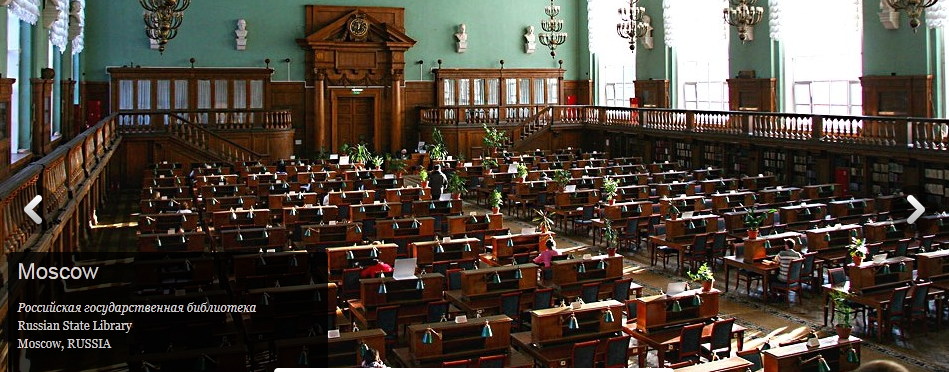
The Fundamental Digital Library of Russian Literature and Folklore
FEB-web (the Fundamental Library of Russian Literature and Folklore) is a project of Gorky Institute of World Literature and the Informregistr Center at the Russian Ministry for Communications. It has been online since 2002. The site is a mammoth collection of materials on Russian literature and folklore, including full text versions of the major works of Russian literature, links to numerous literary and cultural guides and manuals, as well as a wealth of bibliographic guides detailing materials available from the most broad (Pushkin) to the most specific (historical works published in 1860). Feb-web is not specifically linked to any particular physical collection, like the Russian State and National Libraries, but rather work in partnership with numerous institutes, museums, university departments and individual scholars to make researching Russian literary history as accessible as possible on the web. Unfortunately, having so much information accessible on one site requires considerable familiarization with the content before the site can be used for searching for specific information as opposed to simply general browsing. This all the more true because the overall organization of the site content is somewhat confusing. Nevertheless, arguably no other single site in the sphere of Russian cultural and literary studies attempts or succeeds to bring as much under one roof. Everyday the operators of Feb-web attempt to place a new useful link for academic research, and as such the site is useful if for no other reason than to simply keep abreast of changes in online materials available in the field. Because there is not a search interface associated with Feb-web (rather, one browses the text available and links on the particular subjects they find interesting) using the site in English can be useful for those with limited or no Russian language ability. However, researchers must keep in mind that not everything on Feb-web is available on the English-language version.

Because there is a vast amount of information on Feb-web, it would not be useful to attempt to describe it all in a guide of limited space. The importance of the site is better served by simply bringing some examples to light as an invitation for researchers to familiarize themselves with it. There are numerous avenues one could pursue in terms of content, which has more to do with one’s scholarly specialization more than anything else. As a general Feb-web browsing principle, as long as the link has a “plus” sign before it, it can be broken down into smaller parts, which means its text will not be viewable. If one clicks on the link at this point, it will simply open the same screen in another tab. You must get the end of the line (the electronic sheet image before the link has “lines of text” and not a plus sign) before actual text becomes available. Usually, this means so many levels within the online outline that among the tabs over the text is one titled “path,” which if clicked will show you how you got to the page you are at and how to get back. This is extremely useful in order to avoid getting lost and needing to return to the home page, thereby sometimes losing the progress made in finding very specific and particular materials. The word maze is not inappropriate for this site. Following are some specific examples of what can be found on Feb-web.
- One of the important serials sites one can access through Feb-web is Zhurnal’nyi zal, http://magazines.russ.ru/. Here patrons can find a wealth of links to Russian scholarly (“fat”) journals. In some cases, this access includes full-text articles (under the archives tab). More often it includes an index of the publication’s history, as well as in some cases useful announcements about current or future projects under the “obozren’ie” tab.
- Patrons can access full-text versions of essential bibliographic sources such as Lisovskii’s Russkaia periodicheskaia pechat’, 1703-1900 gg. and its successor, Bibliografiia periodicheskikh izdanii Rossii, 1901-1916 under a tiny link called “Periodika” near the bottom of the “Deistvuiushchie izdaniia” section in the left sidebar. Once the source is located, it then requires a minimum of six (non-intuitive) clicks into the specific layout of the source before any of the text can be viewed.
- Full text collection of a tremendous amount of Russian literature. Not only the international renowned authors but lesser known materials also, such as Protopop Avvakum’s 17th century guide for “How to Live in the Faith.”
- Various specific works of literature, including poetry, prose, biography, autobiography, correspondence, etc. available in full-text in a host of paths toward specific authors or entire fields of literary scholarship. For example, a collection of memoirs, correspondence and documents are available through the “Rossiiskii Arkhhiv.”
Archives of Russia
This is the central site of the Federal Archival Service, founded within the Russian Ministry of Culture in 2004 in attempt to centralize information on conducting research in Russian archives, as well as legislation pertaining to the various archival agencies across the Russian Federation. From this home site it is best to link to the “Map of the Site,” from where one can access the main site menu through the left-side fly out menu. Also from this site it is possible to access the home site of the Federal Archival Service at http://archives.ru/, where one can find information on the service itself, view legal and budgetary information concerning the creation of this service within the culture ministry, participate in an online forum discussing issues concerning the service (or just read about what people are saying), etc.The unified archival search engine (described below) is also accessible from this site, although not the individual archival search.

Perhaps more central for the researcher looking at working in Russian archives is the list of the numerous, individual archives in Russia that one can access through rusarchives.ru, at http://guides.rusarchives.ru/search/basic/BasicSearch.html;jsessionid=abcpjH-SyQ-OJexHyNTyv . Each of the individual archives listed at this site is a link to a portal containing more information about the holdings, location, collections, and administration of that particular archive, together with contact information and, in some cases, pdf or PowerPoint presentations about specific holdings, procedures, etc. It is also possible to visit the sites of the individual databases of the participating archives of the Archival Service through their listing site, at http://www.rusarchives.ru/elektronnye-opisi-federalnyh-arhivov, which also has a listing of archival OPACs on the bottom half of this page. The Federal Archival Service also has a centralized search engine at http://portal.rusarchives.ru/poisk.shtml, which can perform two kinds of searches. First, It can search through archival sites on the Runet (Russian Internet), which includes 84 archival cites affiliated with the Federal Archive Service; it can search this entire database or be instructed to search particular holdings. Secondly, it can search the site of the Archives of Russia (the Archival Collection of the Russian Federation, pictured below), which grants access to the catalog records of more than 600 million items, or some 8.5 million kilometers of combined shelf space, according to the Archival Service management.
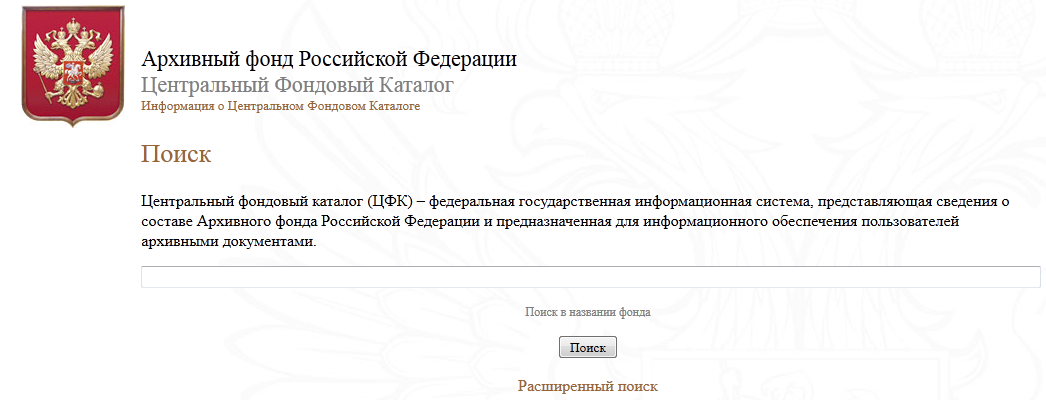
In addition to the above, another useful site, particularly for scholars who are planning to go to Russia, is the Exhibitions site, which lists the current special exhibitions and other programs currently taking place in the various archives of the Archival Service, http://www.rusarchives.ru/evants/exhibitions/index.shtml. The site has an archive of it own as well, so patrons can search to see what special events have been held among the archives beginning with the year 2000. Some specialized exhibitions develop into permanent parts of the online archival service collection, such as the exhibit “Victory, 1941-45,” now complete with its own search engine for wartime archival materials, available at http://rusarchives.ru/novosti/vystavki/05-05-2016-otkrytie-istoriko-dokumentalnoy-vystavki-1941-v-shtabah-pobedy.
Russian State Public Historical Library
The Russian State Public Historical Library (Gosudarstvennaia publichnaia istoricheskaia biblioteka Rossii, GPIB), often called simply the Historical Library, has one of the best specialized collections of historical titles and bibliographic guides useful in pointing scholars toward additional sources. The library was formed in 1863 as the Moscow City Chertkov Public Library, when most of its original collection was based on the personal library of Aleksandr Dimitrievich Chertkov. The collections of the library grew in the second half of the 19th century largely through donations from historical libraries of other wealthy Russian donors. In the aftermath of the October Revolution, its holdings swelled from various collections of abolished organizations (especially religious ones) and nationalized institutions. In the 1930s and 1940s, GPIB received another significant amount of materials from items confiscated by state security organs during the terror. Finally, many materials from Germany and Eastern Europe ended up on its shelves after the end of WWII. Current holdings approach 4 million volumes, mostly on history and publications relating to history in Russian and foreign languages. Its present name dates to 1938.

The home website of the Historical Library contains multiple research possibilities. An important project direction for the library since 2002 has been the digitization of rare books for preservation purposes. GPIB’s digitization program for these materials is the same as the one in use for Bibiliophika (below). The GPIB usually has several special projects running, which patrons can read about under the “projects” tab. Through the “Catalog” tab, patrons can access the GPIB electronic database, which contains all titles that have entered into GPIB’s collection since 1996, and many of the titles since 1993. Additionally, journals entered into the collection since 2000 can be accessed through the digital catalog. Unfortunately, Ukrainian and Belorussian materials are not included in the online database, although some foreign materials are, including in French, English, and German. In fact, there are three catalogs covered within the online interface (from the pull-down menu under the first search window titled “Search in the catalog”): the electronic catalog for current and recent materials, the systematic catalog for access to digitized cards from the GPIB’s card catalog (currently only those since 2000 have been digitized); and the Catalog of Non-traditional Printed Materials. The latter contains over 7000 titles of periodicals, short-tun publications, brochures, agitation pamphlets and other materials generally of a political nature. The collection began in 1989 when Russia was headed for political turmoil and has grown on similar materials since.

Bibliophika
http://www.bibliophika.ru/index.php?sh=proj
Bibliophika is the specialized, full-text online catalog created for the collections of the Russian State Public Historical Library. Currently, Bibliophika provides full-text access to 1235 volumes that have been digitized, equal to almost half a million pages. All of these are from pre-revolutionary texts and include Russian imperial legal publications, bibliographic guides on history, geography, and ethnography of Russia, as well as texts about genealogy, heraldry and history of culture. The GPIB administration has established two methods of accessing the library’s materials: guest and subscription. Guest entrance is open to everyone and permits browsing all the digitized titles in GPIB’s collection, although in low-resolution and not all pages. A subscription permits unlimited access to all materials in high resolution. Subscribing has to be done by writing directly to the GPIB administration, which can be done through their website.
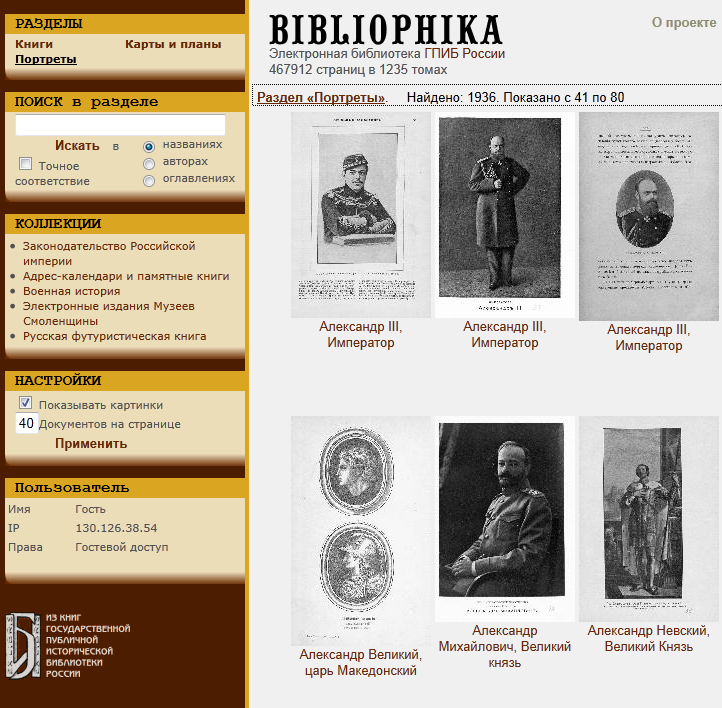
Using the OPAC to access GPIB’s digitized collection is relatively straightforward. The first top-left window is called “divisions,” and allows patrons to choose either books, portraits, or maps and plans as the goal of their search. While there is a search mechanism within the OPAC, the limited size of the digitized collection makes browsing a real alternative. If any of the three divisions is chosen, it pulls up a list of browseable, linkable items that appear to the right of the search block. However, this can take a while if as views are limited to the automatic 40 items per page, as there is no way to skip forward. It is possible to change the setting to display more than 40 items at once, however. The portrait file currently houses 1936 items, the maps and plans file displays 497 items, and the books file contains 335 files listed in alphabetical order. Books are possible to divide further by choosing a particular collection in the window under the search portal. While the browser of the digitized materials is sufficient for maps and portraits, for books there is some inconvenience in that skipping within the file is not possible, rather the patron must page through the text one page at a time either forward or backward. The amount of materials that have been digitized from GPIB’s collection is tiny, but some of these books are important guides to materials that are visible and certain to be useful to individuals without access to bibliographic collections. This small amount of digitized material will hopefully grow.

Runivers
By declaration of its creator ( the Autonomous non-profit organization to create, support and develop the historical and cultural encyclopaedia and Libraries ” Runivers ” ), the purpose of Runivers is to provide access to books, texts, and primary resources on Russia and Russian culture to anyone with internet access both in Russia and all over the world, thereby making accessible materials that are currently in book depositories, state libraries and archives and are available to a limited number of people either because of subscription limitations or geographical reality. The core project has been to place collected works – mostly history and philosophy from the last half century of the Russian Empire – into and electronic facsimile library that can be accessed from the Library tab on the home website. Holdings under this tab are organized into either an alphabetized catalog or one divided into different categories, including (listed in order of appearance): atlases, bibliographic guides, war history, general history, journals/periodicals, Russian (fatherland) history, military/regimental history, travel literature, Russian philosophy, document collections, encyclopedias and dictionaries. Patrons can then link onto their desired items and download the entire text either via pdf or DjVU. The final link on the tab is for new items entering the collection.
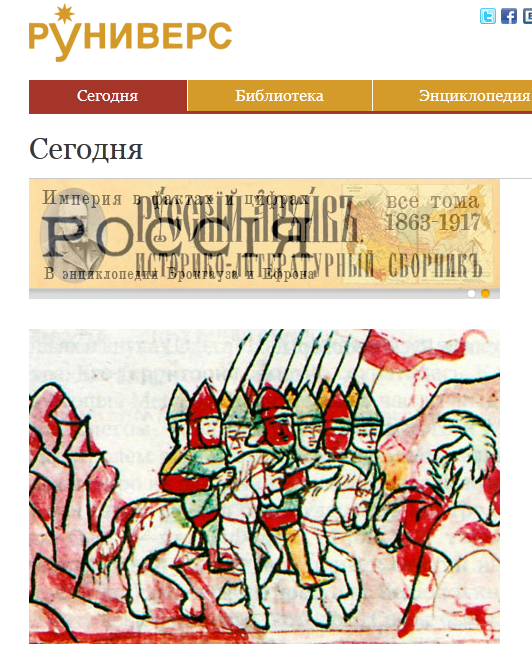
Under the Encyclopedia tab, patrons can use the search interface created by Runivers to browse the encyclopedic information digitized in their database. This is very useful, and the database is promised to keep expanding. Unfortunately for the moment, there are only three encyclopedias that comprise the entire content of this database, and they are all pre-revolutionary military encyclopedias. These include the 8-volume Encyclopedia of War and Naval Sciences from 1883-97; the 14-volume Encyclopedia of Military Lexicons, 1852-58; and the 18-volume War Encyclopedia from 1911-1915. Additionally, Runivers users can access more mostly Russian imperial military history through the Projects tab, although there are additional materials on Russian philosophy, general history, numerous maps from the Runivers encyclopedia collection, and a file or recorded lectures on historical topics mostly from Russian historians and intellectuals. Finally, in the tab Historical gallery, patrons can browse through an exceptional collection of historical Russian maps and atlases dating to the reign of Peter I; an exceptional collection of Russian photographs from the late Russian Empire; and a collection of Russian illustrations and painting on topics concerning national history, complete with annotated descriptions about the work and the historical subject depicted.
Russian Union Catalog
The Russian Union Catalog, or more fully, the National System of Shared Cataloging (Национальной системе корпоративной каталогизации [СКБР]), is an important and useful project undertaken by the National Library Information Center Libnet to combine digitized records of a multitude of Russian libraries, archives, and museums into one database and make them searchable. It is the largest online database in the Russian Federation or anywhere is the world specializing in Russian, East European and Eurasian materials, with over 6 million bibliographic references and some 20 million item records. Currently, the Union Catalog provides shared, online access to 169 Russian library information collections. Participants in the sharing project include the most important library collections in the country, including the National Library, the State Library, the Yeltsin Presidential Library, the Academy of Sciences, the State Public Historical Library, numerous central Russian libraries specializing in particular topics and dozens of regional libraries. In the Russian case access to regional libraries has not been historically as important as in some other places because of the censorship requirements to deposit copies of everything published in central depository libraries. Nevertheless, one can still find materials in regional collections unavailable elsewhere, and hopefully it will be increasingly possible to view them through the Union Catalog. Furthermore, the advantage of having access to such collections in post-communist Russian is even more pronounced.

The database search interface permits several means of searching. The simple search is performed using key words, author/creator, title, name/subject title, or subject area. The advanced search permits entry of three separate search terms, each with the first five choices from the simple search (without subject area) and ISBN, publisher and place of publication, for a total of eight possible terms. Additional specifications on the Advanced Search permit entry of language, audience (children, adult, or all), year of publication, and document format, including printed text, manuscript, audio, map, photograph, etc. Searching is best performed in Russian, however, it is possible on the Advanced Search option to enter search terms in other languages and press the dictionary key, which will produce a listing of possible terms in both Russian and transliterated Latin-script (transliteration is based on the German method) with the amount of titles under that particular term, which may then be selected. The catalog is particularly useful in that a general search of participating members can be performed and information about the whereabouts of the particular item within Russian collections (similar to the methodology of WorldCat or Karlsruhe) obtained. Typical search results look as follows:
